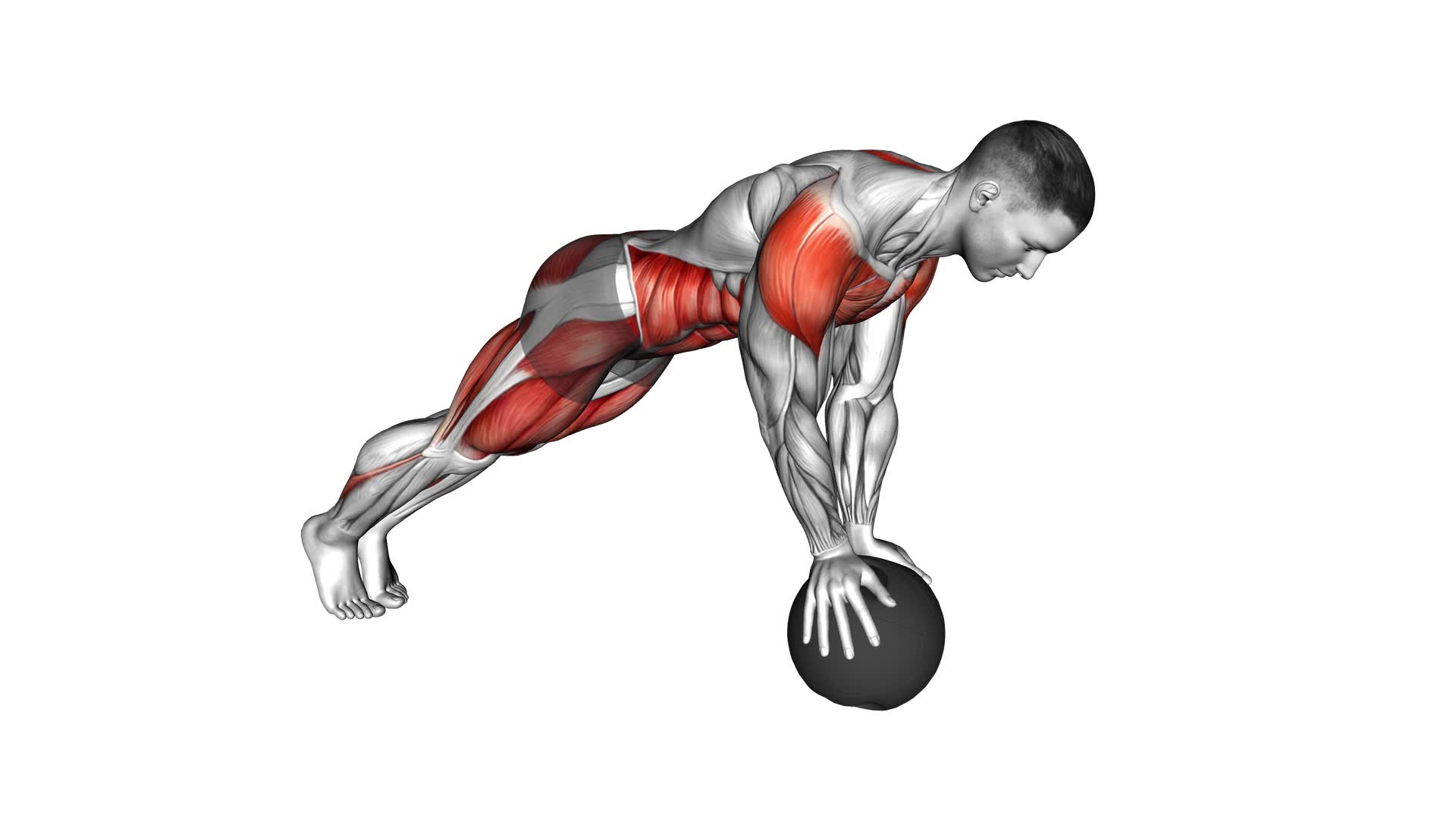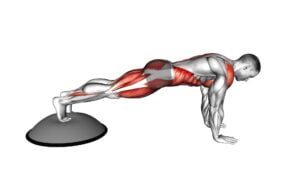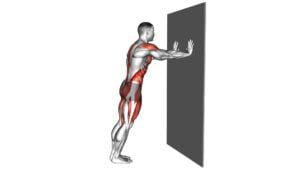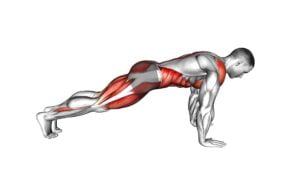Medicine Ball Mountain Climber (male) – Video Exercise Guide & Tips

Are you looking for an exercise that will challenge your entire body? Look no further than the Medicine Ball Mountain Climber.
Watch This Exercise Video
This intense workout targets your core, arms, and legs all at once, helping you build strength and improve your overall fitness.
In this video exercise guide, we'll show you the proper form and technique to perform the Medicine Ball Mountain Climber. Get ready to take your workouts to new heights with this dynamic exercise.
Let's get started!
Key Takeaways
- Medicine Ball Mountain Climber targets core, arms, and legs simultaneously.
- The exercise engages multiple muscle groups and builds strength while improving overall fitness.
- Incorporating slow and controlled movements in the exercise reduces the risk of injury and enhances balance and stability.
- Adding Medicine Ball Mountain Climber to your cardio routine provides a cardiovascular workout, targets core muscles, and improves overall fitness level.
Benefits of the Medicine Ball Mountain Climber
You'll reap numerous benefits from incorporating the medicine ball mountain climber into your workout routine. This exercise not only challenges your entire body, but also improves your cardiovascular endurance and core strength. By engaging multiple muscle groups simultaneously, you can maximize your time at the gym and achieve efficient results.
One of the major benefits of the medicine ball mountain climber is its ability to increase your heart rate and improve cardiovascular fitness. As you perform the exercise, your heart works harder to supply oxygen to your muscles, enhancing your overall cardiovascular endurance. This can lead to increased stamina and improved performance in other physical activities.
Additionally, the medicine ball mountain climber targets and strengthens your core muscles. By maintaining a stable plank position and bringing your knees towards your chest, you engage your abdominal muscles, obliques, and lower back. This not only helps to improve your balance and stability, but also enhances your overall core strength.
To ensure you get the most out of this exercise, it's important to maintain proper form. Start in a plank position with your hands on the medicine ball and your body in a straight line. Keep your core engaged and avoid rounding your back. As you bring your knees towards your chest, focus on using your core muscles to lift your hips, rather than relying solely on momentum.
Incorporating the medicine ball mountain climber into your workout routine can offer a wide range of benefits. From improving cardiovascular endurance to strengthening your core, this exercise can help you achieve your fitness goals more effectively. Remember to always maintain proper form to avoid injury and maximize your results.
Equipment Needed for the Exercise
To perform the medicine ball mountain climber exercise, you'll need a medicine ball. Here are some other pieces of equipment that can enhance your medicine ball exercises and provide an alternative workout experience:
- Weighted Vest: Adding a weighted vest to your medicine ball mountain climbers can increase the intensity of the exercise and help build strength and endurance.
- Resistance Bands: Incorporating resistance bands into your medicine ball workouts can engage more muscles and challenge your stability and coordination.
- Sliders: Sliders are small discs that you place under your hands or feet to create instability. Using sliders with your medicine ball mountain climbers can intensify the exercise and target your core and upper body.
- Balance Board: Using a balance board while performing medicine ball exercises adds an element of instability, forcing your muscles to work harder to maintain balance.
By incorporating these additional pieces of equipment, you can take your medicine ball workouts to the next level and achieve even better results.
Now that you know what equipment you need, let's move on to the step-by-step guide on how to perform the medicine ball mountain climber exercise.
Step-By-Step Guide on How to Perform the Exercise
To perform the medicine ball mountain climber exercise, begin by placing both hands on the medicine ball and assume a push-up position. Ensure that your hands are directly underneath your shoulders and your body is in a straight line from your head to your heels. This is the starting position.
Now, brace your core and engage your upper body muscles. Keep your abs tight and your back flat throughout the exercise. This will help maintain proper form and prevent any unnecessary strain on your lower back.
Next, start by bringing one knee towards your chest, while keeping the other leg extended behind you. Alternate between legs in a controlled and rhythmic manner, as if you're climbing a mountain. As you bring one knee in, try to touch your elbow on the same side for an additional challenge and to engage your obliques.
Remember to breathe throughout the exercise. Exhale as you bring your knee towards your chest and inhale as you extend your leg back. This breathing technique will help you maintain a steady rhythm and provide oxygen to your muscles.
Continue the exercise for the desired number of repetitions or time.
Common Mistakes to Avoid During the Medicine Ball Mountain Climber
When performing the medicine ball mountain climber, there are a few common mistakes that you should avoid.
First, make sure to have proper hand placement on the medicine ball, ensuring that your palms are flat and your fingers are spread wide. This will help you maintain stability and prevent your hands from slipping.
Second, remember to engage your core muscles throughout the exercise to keep your body stable and prevent any unnecessary strain on your lower back.
Lastly, focus on slow and controlled movements, rather than rushing through the exercise. This won't only maximize the effectiveness of the exercise but also reduce the risk of injury.
Proper Hand Placement
Place your hands firmly on the medicine ball to ensure stability and prevent common mistakes during the Medicine Ball Mountain Climber exercise. Proper hand placement is essential for maximizing the benefits of this exercise and maintaining proper form. Here are the key reasons why hand placement and wrist alignment are crucial:
- Enhanced Stability: Placing your hands firmly on the medicine ball creates a stable base, allowing you to perform the exercise with control and balance.
- Reduced Risk of Injury: Proper hand and wrist alignment help distribute the weight evenly, minimizing strain on your joints and reducing the risk of injury.
- Improved Core Activation: By engaging your core muscles to maintain stability through your hands, you'll experience increased activation in your abdominal muscles, making the exercise more effective.
- Better Upper Body Strength: With correct hand placement, you'll engage your upper body muscles, including your shoulders, arms, and chest, allowing you to build strength in these areas.
Engage Core Muscles
Firmly engaging your core muscles is crucial to avoid common mistakes during the Medicine Ball Mountain Climber exercise. Core engagement refers to activating your abdominal, lower back, and hip muscles to stabilize your body during the movement. When your core isn't properly engaged, you may experience lower back pain or find it difficult to maintain proper form.
To engage your core effectively, start by drawing your belly button towards your spine and tucking your pelvis slightly. This will help create a stable and strong foundation for the exercise. Remember to maintain core engagement throughout the entire movement, keeping your body in a straight line from head to toe.
By focusing on core engagement and maintaining proper form, you'll maximize the benefits of the exercise while reducing the risk of injury.
Transitioning into the subsequent section about 'slow and controlled movements', you should also pay attention to the speed at which you perform the Medicine Ball Mountain Climber for optimal results.
Slow and Controlled Movements
To execute the Medicine Ball Mountain Climber with precision and avoid common mistakes, focus on maintaining slow and controlled movements throughout the exercise. Proper form and technique are crucial to maximize the benefits of this exercise. Here are some key points to keep in mind:
- Slow and controlled movements: Avoid rushing through the exercise. Instead, focus on performing each movement in a deliberate and controlled manner. This will help engage the targeted muscles effectively and reduce the risk of injury.
- Maintain a stable core: Keep your core muscles engaged throughout the exercise. This won't only improve your balance and stability but also enhance the effectiveness of the workout.
- Avoid excessive bouncing: Control the movement of the medicine ball and avoid excessive bouncing. This will ensure that you maintain control over the exercise and prevent any strain on your joints.
- Breathe properly: Remember to breathe steadily and rhythmically during the exercise. This will help you maintain focus and provide your muscles with the necessary oxygen.
Variations and Modifications for Different Fitness Levels
Looking to challenge yourself or modify the medicine ball mountain climber exercise? There are a few options for you to consider.
If you're a beginner, start by performing the exercise without a medicine ball, focusing on maintaining proper form and stability.
For those looking for a more advanced variation, try incorporating a weighted medicine ball into the exercise to increase the intensity and engage your core even further.
And if you're really looking to push your limits, you can explore different equipment variations, such as using a stability ball or a TRX suspension trainer, to further challenge your strength and stability.
Beginner Modifications
Start by placing your hands on an elevated surface, such as a step or bench, before performing the Medicine Ball Mountain Climber exercise. As a beginner, it's important to modify the exercise to suit your fitness level. Here are some beginner modifications and proper form tips to help you get started:
- Slow down the movement: Take your time and focus on performing the exercise with control. This will help you maintain proper form and reduce the risk of injury.
- Reduce the range of motion: Instead of bringing your knees all the way to your chest, start by bringing them towards your elbows at a comfortable range. Gradually increase the range as you get stronger.
- Use a stability ball: If placing your hands on an elevated surface is too challenging, try using a stability ball instead. This will provide extra support and stability during the exercise.
- Start with fewer repetitions: Begin with a lower number of repetitions, such as 5-10, and gradually increase as you build strength and endurance.
Advanced Variations
Continue progressing your Medicine Ball Mountain Climber exercise by exploring advanced variations and modifications to challenge your fitness level. Once you have mastered the basic form of the exercise, you can begin incorporating advanced modifications to take your workout to the next level.
One way to do this is by incorporating weights. Adding weights, such as dumbbells or a weighted vest, increases the resistance and forces your muscles to work harder. This can lead to greater strength gains and improved muscular endurance.
Additionally, advanced modifications like performing the exercise on an unstable surface, such as a stability ball, can further challenge your core stability and balance.
By incorporating these advanced variations, you can continue to push your limits and achieve even greater results.
Now, let's explore how incorporating equipment can further enhance your progression.
Incorporating Equipment for Progression
To further enhance your progression in the Medicine Ball Mountain Climber exercise, incorporate equipment such as weights or an unstable surface to challenge your fitness level and continue pushing your limits. Here are some progression techniques and equipment alternatives to consider:
1) Weighted Medicine Ball Mountain Climbers: Hold a medicine ball in your hands while performing the exercise. This added resistance will increase the intensity and engage your core and upper body even more.
2) TRX Mountain Climbers: Attach the TRX straps to an anchor point and place your feet in the foot cradles. This unstable surface will require more stability and core engagement, making the exercise more challenging.
3) Bosu Ball Mountain Climbers: Place your hands on a Bosu ball, with the flat side down. This unstable surface will work your stabilizer muscles and challenge your balance.
4) Resistance Band Mountain Climbers: Attach a resistance band around your ankles or knees. The band will provide resistance throughout the movement, activating your leg muscles even more.
By incorporating these equipment alternatives, you can take your Medicine Ball Mountain Climber exercise to the next level.
Now let's move on to some tips for incorporating this exercise into your workout routine.
Tips for Incorporating the Medicine Ball Mountain Climber Into Your Workout Routine
To enhance your workout routine, try incorporating the medicine ball mountain climber exercise. Not only does this exercise target your core muscles, but it also provides a great cardiovascular workout. Here are some tips for proper form in the medicine ball mountain climber and the benefits of adding this exercise to your cardio routine.
Firstly, it's important to maintain a strong plank position throughout the exercise. Start by placing your hands on the ground shoulder-width apart and your feet on the medicine ball. Keeping your core engaged and your body in a straight line, bring one knee towards your chest while maintaining a stable upper body. Alternate legs and continue the movement in a controlled manner.
Proper form is crucial to maximize the benefits of this exercise. By engaging your core and maintaining a strong plank position, you'll effectively work your abs, shoulders, and hip flexors. Additionally, the fast-paced nature of the medicine ball mountain climber elevates your heart rate, making it a great addition to your cardio routine.
Incorporating the medicine ball mountain climber into your workout routine can help you improve your overall fitness level. It challenges your core stability, strengthens your upper body, and improves your cardiovascular endurance. So, why not give it a try and take your workouts to new heights?
Frequently Asked Questions
How Many Calories Does the Medicine Ball Mountain Climber Burn?
When it comes to burning calories, the medicine ball mountain climber is a great exercise choice. Not only does it strengthen your core and upper body, but it also gets your heart rate up, leading to increased calorie burn.
If you're looking for alternative exercises that offer similar calorie burning benefits, you can try high-intensity interval training (HIIT), burpees, or jump squats. These exercises will help you torch calories and get closer to your fitness goals.
Can the Medicine Ball Mountain Climber Help Improve Core Strength?
The medicine ball mountain climber is a great exercise for improving core strength. By engaging your core muscles as you bring your knees towards your chest, you'll be working to stabilize your body and develop a strong core.
This exercise also helps to improve endurance as it requires a combination of strength and cardiovascular fitness.
Plus, there are variations of the exercise that you can try to target different areas of your core for a well-rounded workout.
Is the Exercise Safe for Individuals With Lower Back Pain?
If you're dealing with lower back pain, it's important to exercise caution when performing the medicine ball mountain climber. Modifications can be made to make it safer for you.
Consider placing your hands on an elevated surface like a bench or step to reduce the strain on your lower back. Additionally, focus on engaging your core muscles and maintaining proper form throughout the exercise.
Always listen to your body and stop if you experience any discomfort or pain.
Can the Medicine Ball Mountain Climber Be Done by Beginners?
Yes, the medicine ball mountain climber can be done by beginners. It's a challenging exercise that targets multiple muscle groups, including the core, shoulders, and legs.
By incorporating the medicine ball, you add an extra element of instability, which improves your balance and coordination.
This exercise is a great way to increase strength and burn calories. Just make sure to start with a lighter medicine ball and focus on maintaining proper form to avoid injury.
How Often Should the Exercise Be Performed to See Results?
To see results from the medicine ball mountain climber, you might be wondering how often you should perform the exercise. Well, it depends on various factors like your fitness level and goals.
Generally, to see noticeable results, it's recommended to do the medicine ball mountain climber at least three times a week. This frequency allows your muscles to recover while still challenging them enough to see improvements.
Conclusion
Incorporating the medicine ball mountain climber into your workout routine can offer numerous benefits.
Not only does it engage multiple muscle groups, but it also improves core strength, balance, and cardiovascular endurance.
By following the step-by-step guide and avoiding common mistakes, you can perform the exercise effectively.
Additionally, with variations and modifications available, individuals of different fitness levels can engage in this challenging workout.
So grab a medicine ball and start climbing to new heights of fitness!

Author
Years ago, the spark of my life’s passion ignited in my mind the moment I stepped into the local gym for the first time. The inaugural bead of perspiration, the initial endeavor, the very first surge of endorphins, and a sense of pride that washed over me post-workout marked the beginning of my deep-seated interest in strength sports, fitness, and sports nutrition. This very curiosity blossomed rapidly into a profound fascination, propelling me to earn a Master’s degree in Physical Education from the Academy of Physical Education in Krakow, followed by a Sports Manager diploma from the Jagiellonian University. My journey of growth led me to gain more specialized qualifications, such as being a certified personal trainer with a focus on sports dietetics, a lifeguard, and an instructor for wellness and corrective gymnastics. Theoretical knowledge paired seamlessly with practical experience, reinforcing my belief that the transformation of individuals under my guidance was also a reflection of my personal growth. This belief holds true even today. Each day, I strive to push the boundaries and explore new realms. These realms gently elevate me to greater heights. The unique combination of passion for my field and the continuous quest for growth fuels my drive to break new ground.







